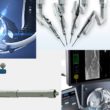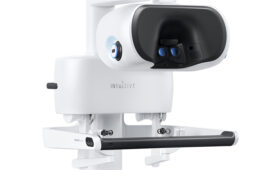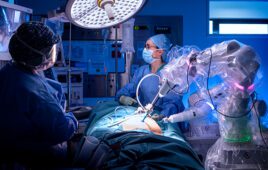
Surgeons at WRAMC perform surgery using a robotic system. [Photo by Sgt. 1st Class Roger J. Mommaerts Jr. from www.army.mil via Flickr, Creative Commons.]
The irony is that Smith is pretty sure that today’s surgical robots are going to be so outdated someday that our grandkids will think they’re funny, in the same way that we roll our eyes at cell phone bricks and 8-tracks. Recent history, according to Smith, informs us about this not-too-distant future.
Smith said that in the last several years, a few surgical robot companies have come onto the scene and are vying for market share. In the realm of abdominal or thoracic robotics, da Vinci is starting to get some competition.
“The market is getting really interesting – all these companies charging towards the market, and more importantly, seeking some kind of differentiation for their device,” said Smith. “They are wrestling with 2 key questions: What can we do [for] physician and hospital customers and how can we get them to switch?”
Most of the companies working to enter the surgical robots space are still under non-disclosure, although there are plenty of firms that will be on the market within the next 3-5 years.
In the thoracic/abdominal space, Smith was most familiar with TransEnterix and it’s Senhance device. He noted that there are some intriguing decisions TransEnterix has made that might be compelling to potential buyers.
There are a few ways companies hoping to enter the market share can answer the 2 questions:
- Price advantage;
- Surgeon preferences;
- Capabilities/features advantage;
Pricing for surgical robots
Cost is an easy discussion to have, said Smith. Everything’s in numbers and it is not a judgment call. To purchase the da Vinci robot, hospitals can expect to spend between $1.6 million and 2 million for the initial investment. The hospital expects to earn that money back within 5 years.
Once the hospital has the machine, it must purchase the instruments to go with surgical robots. Each instrument costs between $1500-2000 and can be used for up to 10 surgeries. Smith explained that at the end of 10 surgeries the instruments are disabled, meaning each individual surgery is between $150 and $250 for the instrument used, depending on the complexity.
“So every time I pick up an instrument, I add $150 to the patient’s bill,” said Smith.
There are 2 points at which a challenger could compete on price. “It would be a simple advantage if a competitor could price the device at south of a million and a half, or even south of a million. A device priced at 2/3s or half the price of the da Vinci would get some attention, financially.”
Further, if the instrumentation price was lowered, you could make that case to patients and payers. Smith believes the new companies will spend time ensuring the instrumentation costs are less expensive, either by expanding the reusability and durability or opting for less expensive machinery within the instruments.
Smith admitted that the machinery is far more complicated than trusty stainless steel, which can be sterilized for 100s of uses. But he believes improving durability to improve costs to patients would be a big win.
Surgeon preferences
For Smith, it is a big question whether the companies can come up with a device that can do something the da Vinci cannot do. All the models have been moving towards single-site surgery, he noted. A single port is a desirable advantage to the patient because it results in less scarring, but it can be enormously complex for the surgeon.
To accommodate single-port surgery, instruments have needed to evolve. Initially, the instruments were straight, measuring between 12-16 in long. “If you can imagine, they all kind of wind up stiffly parallel to each other,” Smith said. Because of the tiny space and work site, maybe the size of a peanut in the body, surgeons found the design to be far too limiting.”
The new instruments are longer and flexible, but there are still operational challenges. The instrument in the robot’s right hand slides in from the right and then hits a curve. Inside the body, that instrument becomes the left side. The left hand does the same thing. The method widens the working space within the body from a peanut to an orange, Smith said.
The workspace becomes a mirror image and there are 2 schools of thought on how to work with that result.
First, the robot computers are capable of reversing the translation, meaning a physician would still move the left–hand control and the robot would know to move the control that is ultimately on the left side of the body (even though it is the robot’s right). “The robot can calculate all the angles to figure out what it should do to make your left hand move down 2 cm or forward 2 cm. It takes a lot of software to make that happen.”
Second is to adopt a method specifically to attract laparoscopic surgeons who have spent their career using manually operated instruments. This is where Smith said TransEnterix is trying to differentiate. These surgeons are used to a scissor-like grip. They enter the body through a fulcrum point and have their movements reversed. If they lift their hand, for example, the tip of the instrument moves down. Smith said that skill set is a point of pride: “That mirror imaging is something that they have become extremely proficient with over 10 years of practice of that kind of surgery, so their brains are wired that way and they have great control and dexterity that way.”
He noted that because da Vinci doesn’t operate that way, surgeons with this type of experience may be interested in a system that uses the mirror program. “If you’re a laparoscopic surgeon who’s very well programmed in that kind of movement when you sit down at the TransEnterix robot you should find that what you’re doing with your hand is almost identical to what you’ve been doing with laparoscopic surgery for the last 10 or 15 years. And so, you’re very comfortable with that. You’re right at home. It plays to your strengths and unique training.”
System capabilities
Smith noted that the capabilities among competitors are starting to merge: It may be the hardest way for competitors to differentiate, unless they come up with something really astonishing. However, he said that the capabilities really help make the case for new customers.
All surgical robots have 3D visuals – an advantage over traditional laparoscopy, which is done with 2D visuals. Intuitive provides three arms and a camera to control, TransEnterix “might” offer four arms, although Smith noted that the demo he has used only had three arms.
Control of a third arm is a big deal for surgeons. It operates like a surgical assistant might, e.g., lifting and holding tissue out of the way. Without that robotic arm, Smith said it was “the poor guy’s job just to hold it there in space for the next 45 minutes while the surgeon worked.” With robotic assitance, the surgeon can direct the third arm and then switch away from that instrument. It will hold that tissue and save a human assistant from getting a cramp in their shoulder.
Another advantage is clutching. Clutching is an ergonomic feature that keeps surgeons’ arms in a more relaxed position. The computer intermediates arm movement and obeys the intention of the surgeon’s movement, even if it doesn’t match spatially. A surgeon can move the tip of the instrument a foot deeper into the body, but her arm doesn’t have to travel an entire foot. The surgeon can tap a clutch button and pull the arm back to where it feels comfortable and the tip of the instrument won’t move.
The da Vinci has a clutching feature, and Smith said TransEnterix brings that capability to surgeons who prefer straight stick laparoscopy.
“Laparoscopic surgeons have shared stories about how ergonomically uncomfortable laparoscopic surgery is because they sometimes have to stand next to the bed and lean over the patient to get at certain angles. In some cases, they have to have one arm reach across the patient to hold the instrument that’s coming in from the other side. They have to be on both sides of the patient at the same time.”

[Photo by Redrum0486 Creative Commons via Wikimedia Commons.]
Future surgical robots
It will be interesting to watch how market dynamics play out in the next several years. But Smith said one thing he thinks will happen soon is that both the price and the size of the devices will go down. Robotic-assisted systems “take up a lot of space in the operating room and are expensive to purchase.”
Smith predicted that in 20 to 30 years surgical robots might weigh 100 lbs and come on a little rack that can be moved around the bed. “When our children see what we think of as robotic surgery, it will be like what we think about when we see a cell phone brick from the 1980s: They’ll look at it and laugh.”
If any companies are working on the iPhone 8 of surgical robots, please give the MDO editors a call. Please don’t call us if you are working on what’s going to be robotic surgery’s version of the 8-track.
[Want to stay more on top of MDO content? Subscribe to our weekly e-newsletter.










Agree today’s surgical robots will look old fashioned before long, but not sure I see TransEnterix uniquely solving these problems as compared to today’s market leader. Intuitive’s new “SP” model is single port: https://www.medgadget.com/2014/04/intuitives-new-da-vinci-sp-single-port-minimally-invasive-robotic-system-video.html
Even the current Da Vinci system do a lot of the things described here?
https://www.intuitivesurgical.com/products/davinci_surgical_system/da-vinci-single-site/
Titan Medical also seems to have a single port device…
https://www.youtube.com/watch?v=jIvjvcKA6xQ
Also seems a growing market leader is in a better position to addresss price issues with new models.
Hi Chris. Great to hear from you. Titan Medical is definitely a frontrunner, and we are watching them closely. Glad to see you agree.
You are right, most are going to a single port system. For me, the most important differentiator was whether to have a mirror method or a “left-hand, left robot arm” method. That is where some surgeons might prefer one robot over another. In a future iteration, however, I could see that preference being a user setting. It is going to be so exciting to see where surgical robots go, don’t you think?
About the mirror method being an important differentiator for traditionally trained lap surgeons, if it really is that important it’s a pretty easy additional feature to the robot kinematic software to work in either mode. Intuitive could roll out a software patch with this feature, fully tested and ready for field use on all of their various robots, in 6 to 12 months. I’m surprised they haven’t received that kind of feedback before…perhaps because traditional lap surgeons don’t want to change to robotics or perhaps because it is really easy for them to switch to the new mapping.
Just read this article and thought it was well done. There have been some interesting developments in the space over the past few months. Heather, curious to get your thoughts on the current landscape. Seems as though a tremendous amount of competitors are showing up, most of which haven’t provided a great amount of detail. I thought we would have seen more from Medtronic and SP at this point. Titan looks to be making strides but with ongoing financing concerns. Exciting times!
Thanks for the comment, Sean. Completely agree: There’s been a ton of robotic surgery news lately. https://www.medicaldesignandoutsourcing.com/tag/robotic-surgery/
Sean, you are right on target. I’ve had a few surgical robot companies reach out to me, but considering how many are supposedly coming into the market– not that many. I suspect these other players are struggling with whether to go with off-the-shelf medtech robotic software and other components or design them internally– one is fast, but less lucrative and the other is a decade-long process. They might also be working on haptics technology which is enormously complex and closely guarded but becoming a “must have” for surgical robotics. I’d say Medtronic and its ilk will be watching to buy up a promising starter, but only once they are further along in the process.